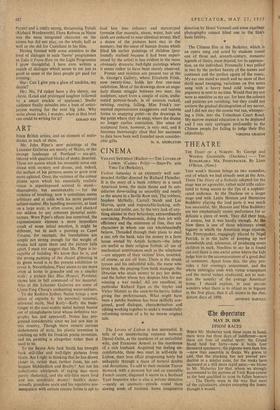FOUR British artists, and an clement of melo- drama in
each of them.
Mr. John Piper's new paintings at the Leicester Galleries arc mostly of Wales, or the strange landscape of Portland — sea-girt, littered with quarried blocks of stone, deserted. These are scenes which his romantic sense can invest with mystery and drama, and, indeed, the surface of his pictures seems to grow ever more agitated. Once, the violence of the colour planes upon which his essentially realistic vision is superimposed seemed to stand— decoratively, but unmistakably — for the violence of bombing; now it sometimes seems arbitrary and at odds with his more pastoral subject-matter. His handling moreover, at least on a large scale, is often coarse, and checked too seldom by any coherent pictorial archi- tecture. Were Piper's effects less contrived, the expressionistic element a more immediate result of some initial emotion, it might be different, but in such a painting as Cape! Trisaint, for example, the foundations are simply not strong enough for the weight of drania laid upon them and the picture falls apart. I must not suggest that Mr. Piper is in- capable of building. We know that he is, and the strong painting of the chapel glittering in itt green wood is in the present exhibition to prove it. Nevertheless, Piper seems to me more often at home in gouache and on a smaller scale : a picture like Blue Houses, Portland, shows him in full command of his material. Also at the Leicester Galleries are some of Chien-Ying Chang's enchanting water-colours. lead him into inflatory •and stereotyped formula (for example, steam, water, hair and cloth are reduced to near-identical terms). Half a dozen of the pictures here stay in the memory, but the sense of human drama which filled his earlier paintings of children (pro., foundly realised because it had been experi- enced by the artist) is less evident in the more obviously dramatic bull-fight paintings where it seems rather to have been merely observed.
Frenzy and violence are present too at the St. George's Gallery, where Elizabeth Frink, now twenty-four, holds her first one-man exhibition. Most of the drawings show an angu- larly titanic struggle between two men; the sculpture, apart from a couple of calm, undis- torted portrait-heads, is of animals racked, twisting, rearing, falling. Miss Frink's tor- mented expressionism exaggerates and tautens forms to snapping point—in the drawings to the point where they do snap, where the drama no longer caries conviction. Her sense of sculptural form, however, is very real, and it becomes increasingly clear that her successes to date have been well founded upon consider-
able gifts. M. H. MIDDLETON


































 Previous page
Previous page